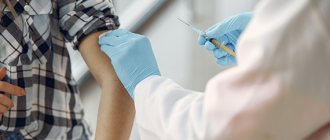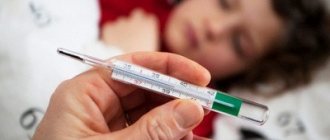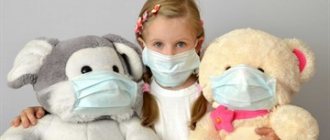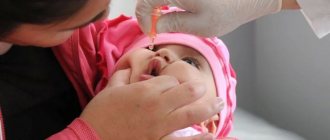Childhood vaccination is a hot topic, especially for parents. Polio vaccination raises many questions. This most dangerous disease of the nervous system often ends in peripheral paralysis. Therefore, polio vaccination is now included in the vaccination schedule.
Immunization is carried out with 2 types of polio drugs in several stages: first with an inactivated vaccine, then with a live one. And this last vaccination scares parents the most: what if the child gets infected with polio from the vaccinated person? Is it possible? Let's figure it out.
Are live vaccine drops dangerous?
So, to combat polio, 2 types of drugs have been created and are still used to this day.
This is an inactivated vaccine containing “killed” poliovirus, administered intramuscularly (also known as IPV). And an oral vaccine consisting of live attenuated viruses (known as OPV) that is dropped into the mouth. It includes strains grown in such a way that their neurovirulence (pathogenicity) is significantly reduced, that is, they are not capable of causing disease.
Once inside, OPV completely imitates the normal entry of pathogen cells into the body. It protects the gastrointestinal tract from infection, preventing viral replication, and therefore the release of pathogenic microorganisms in feces.
But OPV also has a disadvantage - viruses can regain their neurovirulent qualities (for example, if a child suffers from immunodeficiency or pathology of the digestive system), which can cause vaccine-associated paralytic poliomyelitis (VAPP) to develop. And this already threatens an unvaccinated person with infection upon contact with a sick person.
Today, many countries around the world have abandoned the live polio vaccine, where the disease has been completely eradicated. But the Russian Federation is not yet one of them; we still use OPV, although gradually reducing its use.
Polio: how to protect your child
Why is polio so dangerous?
Polio is a highly contagious viral disease that can cause permanent paralysis and death.
By infecting the human nervous system, poliovirus can lead to irreversible damage to the nervous system and motor functions and even death within a few hours. In the vast majority of cases, polio carriers who spread it cannot be detected due to the absence of any signs of the disease at all.
Therefore, if a child suddenly develops signs such as weakness in the muscles of the limbs or pain in the legs or arms, parents should immediately inform health care providers. These could be potential signs of polio. To avoid exposing children to the risk of polio, they should be vaccinated.
How can you prevent infection?
There is no cure for this disease. But it can be effectively prevented through vaccination.
There are two types of safe and effective polio vaccines:
- Oral polio vaccine (OPV) - two drops in the mouth. It is used to stop disease outbreaks and achieve a high level of protection for children in situations where the virus is circulating, as well as for routine immunization.
- Inactivated polio vaccine (IPV), which is given by injection. It is used for routine immunization.
Typically, when polio virus is not circulating in a country, a minimum of four doses of polio vaccine are needed to provide protection.
OPV has been used worldwide to protect children from polio since the 1950s. All of us parents were vaccinated with OPV. Over the past 20 years, this vaccine has saved more than 5,000,000 children from chronic paralysis that could be caused by the polio virus.
IPV and OPV currently used in Ukraine are certified by WHO and purchased by UNICEF.
Is it safe to vaccinate chronically ill children against polio?
It is very important to ensure that children with chronic diseases are vaccinated, since they are more vulnerable to any infections.
True contraindications to OPV vaccination are very rare. Your doctor can determine these. Contraindications for a period of more than two weeks can only be determined by an immunological commission.
Can a breastfed baby be vaccinated?
Yes. Breastfeeding is extremely important and beneficial for the baby's health, but breast milk does not protect the baby from polio.
Why is it so important that all children are vaccinated?
If enough people in a country are vaccinated, the spread of the virus will stop. Conversely, if children in a country remain unvaccinated, this could lead to the spread of the virus and new cases of the disease.
Who is most at risk of contracting polio?
Anyone who is not vaccinated can get sick: both adults and children. Polio most often affects children under 5 years of age.
How does infection occur?
The disease is caused by polioviruses, which usually enter the body through unwashed hands and occasionally through dirty water. They multiply in the epithelial cells of the throat and intestines and can then attack the nervous system.
An infected person can shed the virus even 7-10 days before the onset of the disease and remains infectious for 3-6 weeks after infection. Outwardly, most carriers of the virus cannot be detected in time due to the absence of any signs of illness. Therefore, the virus is especially dangerous for others - the presence and rapid spread of a deadly infection goes unnoticed.
By what symptoms can polio be recognized?
The incubation period for human infection with poliovirus lasts from 4 to 35 days, after which polio may develop. In this case, the manifestations of the disease can be different:
- no symptoms; the disease is asymptomatic in more than 70% of cases, which makes it especially dangerous for others;
- flu-like symptoms (fever, headache, stomach and throat pain, nausea and vomiting) for several days, one at a time or all at once. With this form of the disease, which occurs in 25% of cases, the virus spreads most actively, remaining invisible due to its similarity to flu symptoms;
- movement disorders, which manifest themselves as severe pain in the affected muscles and impaired motor functions up to complete paralysis, which can develop within a few hours. Paralysis can affect the legs, arms, shoulders, chest, abdomen, and face.
Damage to the respiratory muscles often leads to death. When recovering from polio, the function of the nerves and muscles affected by the disease is not restored.
Very rarely, meningitis is also a symptom of poliovirus damage to the central nervous system.
Could polio come back?
It was possible to stop the worldwide spread of a dangerous virus thanks to vaccination. Back in 1988, polio was diagnosed in 350,000 people in 125 countries. By 2014, the number of cases of virus infection had been reduced by 99% to 243.
But as long as the polio virus exists in at least one part of the world, everyone who has not received all the required vaccinations is at risk of contracting it, regardless of their geographic location. People infected with the virus travel and come into contact with others, and polio then spreads again among the world's unvaccinated population.
In 2013, the “wild” polio virus began circulating in Israel: the pathogen was found in wastewater in southern Israel, and then throughout the country. However, due to high vaccination coverage, there were no cases of paralytic polio. To stop the circulation of the virus, Israel conducted a two-round “Two Drops” campaign to immunize children under 9 years of age against polio with a bivalent live vaccine. Due to the risk of importation of the virus, even after circulation has ceased and in the absence of cases of symptomatic disease, Israel returned to the use of OPV (bivalent live vaccine) along with IPV in the mandatory vaccination schedule after the end of the campaign in October 2013.
The risk of a disease outbreak increases during periods of social problems and war because hygiene problems are created, insufficient attention is paid to vaccinations in an overburdened health system, there is a redistribution of funding, a shortage of medical workers, and the like.
In 2010, a polio outbreak in Tajikistan killed 26 people, including 21 children. In total, more than 400 children in Tajikistan were infected with the virus, 170 of them remained paralyzed.
What is the situation with polio in Ukraine?
Ukraine received a warning about the increased risk of a polio outbreak back in 2010 from the European Regional Commission for the Certification of Polio Eradication (RCC).
In October 2013, the WHO Independent Monitoring Board and the Global Polio Eradication Initiative (GPEI) placed Ukraine on the “red list” of countries with the highest risk of disease outbreaks.
As of October 2014, Ukraine remained the only European country on this list due to catastrophically low vaccination coverage.
On September 1, 2015, the Ministry of Health of Ukraine reported that two cases of infection with vaccine-derived polio virus (cVDPV) were confirmed in the WHO regional reference laboratory, where they analyzed the stool of two children from the Transcarpathian region of Ukraine. Two children (one 4 years old and the other 10 months old) were not vaccinated against polio and became ill with a paralytic form of polio. Paralysis in this case, we repeat, cannot be cured. The children were left paralyzed.
Polio outbreaks in any country can only be prevented if at least 95% of children are vaccinated.
In Ukraine, vaccination against polio is included in the list of mandatory preventive vaccinations. Ages for routine vaccinations: 2 months, 4 months, 6 months, 18 months, 6 years and 14 years.
The first two vaccinations are performed with the IPV vaccine (injection) - this is an inactivated vaccine that contains killed polio virus and ensures the presence of antibodies to the virus in the blood. It can be used as a single vaccine or as part of combined multicomponent vaccines (against several diseases at once).
Other vaccinations are usually done with OPV (two drops in the mouth), a live vaccine containing three types of live, weakened polio viruses. Thanks to this vaccine, local immunity is also formed in the intestines, which prevents the further spread of the virus.
Vaccines, including OPV, purchased by United Nations agencies (eg WHO, UNICEF) must meet the criteria established by the WHO Expert Committee on Biological Standardization. These criteria determine the exact composition of the substances used in the production of OPV and ensure the stability of the vaccine composition.
How can WHO guarantee the quality and safety of OPV?
To ensure that all vaccines purchased by UN agencies meet the requirements described above, WHO conducts Good Manufacturing Practice (GMP) testing and ensures that a clear quality control system is in place. Each batch of OPV undergoes full testing at the manufacturer's facilities, and the results of this testing are verified by the national regulatory commission for the quality of biological products in the country of OPV production before the batch of products is sent to the customer.
How should OPV vaccines be stored?
The vaccine remains effective when stored at -20°C or below until the expiration date indicated on the bottle, that is, for two years from the date of manufacture. The vaccine can be stored for six months at temperatures between +2°C and +8°C. Direct sunlight should be avoided on vaccine vials.
It is important to note: it does not matter how many times the vaccine is thawed and frozen (unless it is kept above 8°C). This vaccine remains effective and suitable for use.
If aseptic conditions are not observed at the vaccination site, cloudiness may appear in the vial due to bacterial or fungal contamination. Under no circumstances should you touch the vaccine liquid with your fingers. It is also forbidden to touch the tip of the pipette; during storage, it should always be closed with a lid. Before each use, the vaccine should be checked for purity (transparency), because if it is visibly cloudy, it cannot be used.
What is vaccine-derived poliovirus?
The oral polio vaccine contains live, weakened vaccine viruses that activate the body's immune response. When a child receives OPV vaccinations, the weakened vaccine virus multiplies for a limited time in the intestines, resulting in immunity by creating antibodies. During this time, the vaccine virus is also released from the body. In areas with poor sanitation, the vaccine virus released from the body of a vaccinated person can spread among the immediate environment (and this will help increase the protection of other children through “passive immunization”), but then this virus disappears.
In rare cases, if the level of immunization of the population is very low, the vaccine virus that is released from the body of the vaccinated person can circulate for a long period. The longer it is allowed to circulate, the more genetic mutations it experiences. In very rare cases, the vaccine virus can genetically mutate into a form that causes paralysis, called circulating vaccine-derived poliovirus (cVDPV, or cVDPV).
cVDPV takes a long time to emerge: the strain must circulate in populations with low immunization rates for at least one year. Circulating VDPV occurs when routine or supplementary immunization is not performed at adequate levels and the population remains vulnerable to infection with poliovirus (either vaccine-derived or wild-type poliovirus). Therefore, the problem is not the vaccine itself, but the low level of vaccination coverage. If the population is fully vaccinated, it is protected against both the wild virus and the vaccine-derived virus.
Every year, vaccination prevents hundreds of thousands of infections with wild polio virus.
How can adults protect themselves from polio?
Adults who received all required doses of polio vaccine as children are protected against the disease.
However, in situations of increased risk of contracting the virus, even vaccinated adults should receive at least one additional vaccination.
Additional vaccination against polio is advisable for the following categories of people:
- travelers entering countries at risk of poliovirus infection;
- military in the conflict zone;
- representatives of humanitarian missions;
- employees of laboratories working with the polio virus;
- healthcare workers in contact with people with polio.
An adult who has never received a polio vaccine should receive 4 doses of the vaccine to provide sufficient protection against the disease.
Source
published 24/10/2019 16:32 updated 28/10/2019 — Infectious diseases, Vaccination, Child safety
Live polio vaccine and an unvaccinated child: is there a risk of infection?

VAPP is diagnosed very rarely - one case per 500,000 - 2,000,000 doses. And this happens after the first injection. It has been established that with the second vaccination the frequency of this phenomenon is much less, and with the third it almost never occurs.
The chances of a healthy child getting infected from an injection are negligible. But is it possible to catch polio from someone who has already been vaccinated? Yes, theoretically.
Unvaccinated people suffering from immunodeficiency, pregnant women, and infants with pathologies of the immune system are susceptible to this threat. Therefore, caution should be exercised. In addition, if there are several children in a family, and one has already been vaccinated with OPV, then others who are not vaccinated may become infected with VAPP. It is transmitted through food or household contact.
After the OPV procedure, the virus exists in the child’s intestines for about two months. That is why parents are warned that if their child has just been vaccinated, he is prohibited from attending kindergartens during the above-mentioned period.
It is worth noting that the inactivated version of the vaccine cannot lead to infection. For this reason, some parents choose it.
Remember that viral shedding in children is extremely low, and during transmission, the volume of pathogenic particles decreases several times.
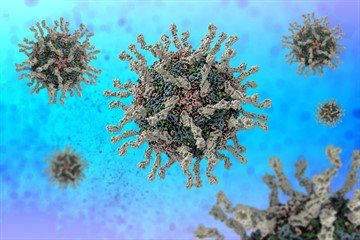
This means that if a child contracts vaccine-associated polio, this is not a reason to panic. As a rule, this infection passes in a mild form, without causing complications.
And yet, can a child infect others after being vaccinated against polio? Such cases are very rare and almost never observed in life. This is why it is important to understand the need for immunization. This is the only way to be sure that the virus will not affect anyone.
Is a child contagious after polio vaccination?
Poliomyelitis is a dangerous viral infection that, when infected, puts the health of a child or adult at risk. Therefore, the vaccine against the disease is included in the National Vaccination Calendar.
Parents are wondering whether it is possible to become infected with polio from a vaccinated child. Fear is associated with the introduction of a weakened but living strain of the pathogen to the patient.
What types of vaccines are used?
There are 2 types of vaccinations, which are selected by the therapist after a general examination and laboratory tests:
- Alive . Used since 1960, contains an active strain of 3 types of pathogens. They are weakened by growing in unsuitable conditions. The virus is alive, but does not cause infection. The vaccine is administered orally because the disease spreads into the human body through the mouth. Humoral cellular immunity is formed. There is a small risk that the infection will worsen when conditions are favorable, which may lead to infection.
- Not alive . Pathogenic microorganisms are completely inactivated. This is done using formaldehyde. The injection is done subcutaneously, intramuscularly. Only humoral immunity is formed. The disadvantage is the lack of protection of the digestive tract: the risk of disease increases even with immunization.
To produce any of these types, 3 strains of pathogens are used.
If a person has been ill with one of these viruses, but has not been vaccinated, re-infection with the other two varieties is possible. Therefore, it is recommended to get vaccinated even in case of illness.
Features of the live vaccine
The vaccine is created in such a way that when it enters the digestive tract, it simulates infection . Therefore, the immune system is unable to distinguish between the spread of a real viral agent and a vaccine.
The microflora of the gastrointestinal tract is optimal for reproduction and spread of infection.
If a person's immune system is weakened, insufficient antibodies are produced. Therefore, the virus has the opportunity to reproduce. It spreads through the mucous membrane, penetrating the bloodstream.
An infection can occur that is dangerous to the life and health of the patient, which is why many countries refuse this method of vaccination.
In Russia, the drug is used everywhere, but each patient has a choice: take the drug with activated strains orally or get a subcutaneous vaccination.
In the latter case, there is no risk at all, since the pathogen is destroyed. Only the antigenic composition remained in the drug.
Is a child contagious after vaccination?
Parents of unvaccinated children worry about spreading the disease. They ask pediatricians whether a child can become infected after vaccination. If a patient is given an inactivated vaccine subcutaneously or intramuscularly, there is no risk of infection.
When using a live vaccine, the patient is at risk of developing the disease. But this happens very rarely.
The process can begin after the first injection. If re-vaccination has been carried out, the risk is reduced. During the third procedure it is absent.
Infection by injection of the drug is possible in patients with the following diseases or conditions:
- congenital or acquired immunodeficiency;
- infants with abnormalities in the development of the immune system;
- pregnant women.
Any child who has been vaccinated orally with active microorganisms should not attend educational institutions for 60 days.
Once infected, polio can be transmitted to other people in the following ways:
- water;
- food;
- contact-household.
This type of infection resolves without complications. With the right treatment, the disease goes away quickly and in a milder form.
Therapy is prohibited without consulting a doctor. It is prescribed only when laboratory tests are completed and the diagnosis is confirmed.
How many days after vaccination with a live vaccine can a child be infectious?
The incubation period after administration of the drug is 2 months. During this time, the child is limited in his access to communication with other children or adults.
This is especially true for those who have not previously been vaccinated.
Even if the patient does not have obvious signs of infection from the drug, there is a risk of an asymptomatic form of the disease. It is unknown whether it is contagious when the live strain is administered.
After passing the incubation period, you need to re-visit the pediatrician, who gives permission to visit educational institutions.
Have there been cases of polio infection from a vaccinated child?
No such cases were identified. However, doctors do not exclude the risk of spreading a dangerous, highly contagious infection, which can be transmitted through household items, dirty dishes, and shared food.
No outbreaks of the disease have been reported in any kindergarten, school or university. This is especially true for groups that recruit children who have completed all the necessary vaccinations.
An unvaccinated child has contact with a vaccinated person: what are the consequences?
This form of infection is possible if the immunity of an unvaccinated baby is weak. In this case, the child is at risk, and after contact you need to monitor him.
Special treatment measures cannot be carried out, since infection is possible only in rare cases.
It is recommended that you see a doctor for testing if you experience 1 of the following symptoms:
- increased body temperature;
- pain in the throat, head;
- sudden loss of strength, malaise, weakness;
- frequent vomiting for no reason;
- muscle stiffness;
- signs of meningitis.
The pediatrician conducts a general examination. Infection is indicated by reduced muscle functionality, difficulty swallowing and breathing reflexes.
If a disease is suspected, laboratory tests are prescribed. To do this, they take a swab from the nasopharynx, feces, and cerebrospinal fluid. This is due to the fact that the pathogen spreads throughout the gastrointestinal tract and nervous system. Conduct virological testing, for example, PCR. The antigenic composition of polio is determined.
If the test detects polio antigens, comprehensive treatment is prescribed. Bed rest, painkillers, artificial ventilation, therapeutic exercises, physiotherapy, and diet are prescribed .
Parents should remember that without obvious signs of illness there is no need to worry. Self-medication is prohibited.
Conclusion
In the fight against polio in the twentieth century, a vaccine was developed that is still effective today.
Weakened children are prescribed only vaccination using an inactivated strain. The drug is safe, but does not guarantee one hundred percent protection after contact with an infected person.
What should you do if an unvaccinated child came into contact with someone vaccinated against polio?
Indeed, what can happen to an unvaccinated baby, for example, in kindergarten when he comes into contact with a vaccinated OPV.
Yes, a vaccinated child releases pathogenic strains into the environment for some time. You need to understand that only virulent viruses pose a danger, and in order to become such, they must undergo a mutation in the intestines of the vaccinated person . This is possible if a person has a serious immunodeficiency, which in itself is a rare case.
Therefore, usually a vaccinated baby releases unchanged (non-dangerous) viruses in much smaller quantities (passive immunization) than they were injected with during immunization. That is, those around you who have received such a small dose simply maintain the tension of the immune system in the team.
This is the purpose of OPV vaccination. But even if we assume that an unvaccinated baby still managed to catch a virulent virus (that is, he also has severe immunodeficiency), the probability of contracting polio is only 5% (or less).

But, even if included in these statistics (which is absolutely incredible), the child is unlikely to get paralytic (which is what everyone is afraid of). The disease will go unnoticed or will be similar to ARVI or an intestinal infection.
And only 2% of children have a chance of getting vaccine-associated paralysis. But do not forget that such a baby has severe immunodeficiency. In addition, the contact must be long and close.
In a kindergarten setting, all of the above points are unlikely to coincide. Therefore, such cases were not recorded.
So, the maximum that can happen is that the child receives passive immunization. It should be remembered that this situation is only permissible with OPV vaccination, since no virus release occurs with IPV.
Who can develop vaccine-associated polio?
In children who have:
- HIV;
- neurological complications after any other vaccinations;
- acute digestive disorders;
- any other viral infection.
These same conditions are contraindications for vaccination. Usually neither parents nor pediatricians ignore any of these conditions. A child can only get sick if he has HIV, but it has not been detected. This happens extremely rarely.
After vaccination, a healthy child may react with an increase in temperature - sometimes on days 5-14, single vomiting, diarrhea, a slight local allergic reaction, loss of appetite, and general malaise. Treatment is usually not required, the reactions are short-lived, this is confirmation that the child’s body is forming an immune defense.
You should only consult a doctor when your child has a high fever or completely refuses to eat after vaccination.
Signs of infection after contact with a child who has been vaccinated
As mentioned earlier, if an infection occurs, then most likely the baby will experience it asymptomatically, or the negative manifestations will resemble a cold or intestinal infection.
But even if the worst thing happened, and the child fell ill with vaccine-associated paralysis (VAPP), this is not a death sentence.
The treated pathology (according to statistical data) leaves paralysis in only 25% of those who have recovered from the disease, and in more than 30% of cases it is cured without consequences.
How does polio manifest? Symptoms of this disease can be diagnosed at different time periods and directly depend on the route of infection. Typically, a vaccine recipient may develop signs of polio within 4-30 days after immunization.
However, if a child is infected through contact with a person vaccinated with a live vaccine, symptoms usually appear after two or three months. Interestingly, immunocompromised individuals may develop vaccine-associated polio after as long as six months.
Based on severity, doctors distinguish three main forms of VAPP:
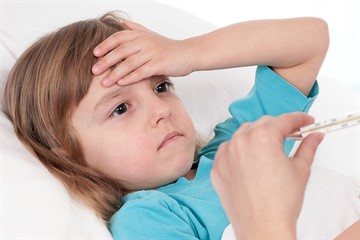
- mild, passing after a month (abortive form);
- paralytic, causing the syndromes of the same name and increasing the fragility of bone tissue;
- and severe, capable of causing disability (muscle atrophy) or even death.
Symptoms of VAPP include:
- headache;
- increase in body temperature;
- muscle twitching;
- cough;
- pain in the back and limbs;
- rhinitis;
- insomnia (or vice versa, drowsiness);
- and dyspeptic disorders.
It should be noted that symptoms rarely last more than a month. But paralytic forms of VAPP are much more difficult for children to tolerate. Here the muscles of almost the entire body suffer greatly.
Vaccinated children are not dangerous to others. The exception is OPV vaccination. After this procedure, the patient releases viral strains into the environment for another 60 days. During this period, if there is close contact, an unvaccinated baby may become infected.

But if by this time he has already undergone 2-fold IPV vaccination, he will never get VAPP, which means he can safely contact people vaccinated with OPV. It should be remembered that a child can only get vaccine-associated polio if he has an immunodeficiency.
However, if there is even potential contact with a vaccinated OPV, the unvaccinated baby should be vaccinated.
If you refuse the procedure, be sure to separate the children for 2 months from the date of oral immunization.
Video on the topic
Is a child contagious after vaccination? An allergist-immunologist answers:
The eradication of polio is the most important global health project, based on the history of the use of 2 highly effective vaccines, which have their pros and cons. First, IPV showed good preventive results, but also multiple adverse reactions. This led to the widespread use of OPV for many years.
But it also had problems - vaccine-related polioviruses and VAPP. Therefore, in recent years there has been a tendency to replace oral polyoprepants with inactivated ones. In some countries, live vaccines are not used at all. Perhaps it will be the same in our country.
However, for now, doctors are guided by the adopted law, according to which the most effective protection against various polioviruses can be achieved by first using IPV and ending with oral vaccines.
